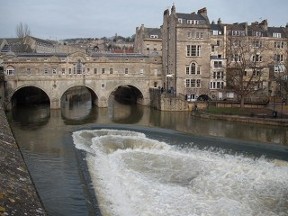
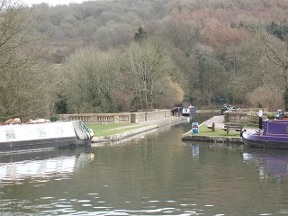
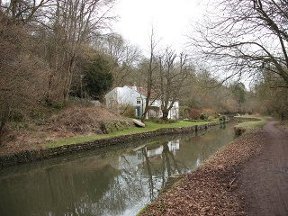
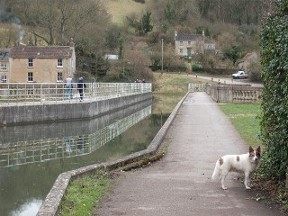
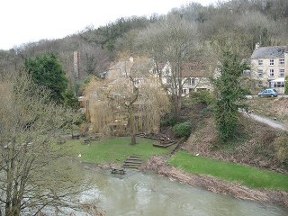
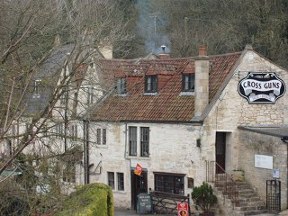
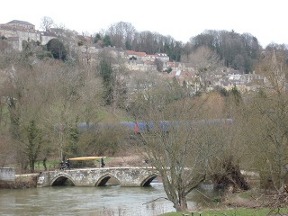
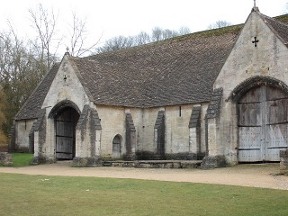
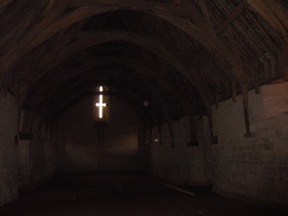
I left Bath at the end of February. The calender said it was spring, but the wind and sky thought otherwise. Winter still held the land in a cold embrace. The trees were silent and bare; the earth was still; no birds sang.
In summer it's good to get away from the city. Green fields and woodland paths entice; and if your wandering leads you at last to some country pub or riverside inn, life can offer no more! But in winter to venture out into the cold and mud is more of a challenge. It's exciting to encounter the elements, but there's a certain apprehension too. You are always aware of the wind and rain and clouds and the gathering night.
The morning was overcast, but it didn't look too bad. I set off from the Abbey, which seemed a suitable place to begin a journey. Then through the crowded streets where everyone had business except myself. I had nothing to do except walk the eight or nine miles to Bradford-on-Avon.
I normally travel alone, but that day I had the company of a dog. He's getting on a bit now and I couldn't take him with me when the serious walking began, but he joined me for the first couple of stages. Happy to be out and about, never complaining, he's a great companion.
I picked up the Kennet and Avon canal in Sydney Gardens, at the end of Great Pulteney Street. From there I went east, following the river between Lansdown and Claverton Down. To my left across the valley, terraces and crescents of warm stone patterned the hillside. Then the view changed: streets and houses were gone and I was on my own.
Bath lies in a deep defile. The encircling hilltops are flat, as if they were once part of a plateau which was cut up and pulled apart. The whole area feels different to the chalk: more enclosed, more claustrophobic. When you climb the downs it's like taking off in an aeroplane. You leave the lowlands and enter the wide realm of the sky. To scramble out of these Somerset valleys is to emerge from the sea. The high ground is dry land, and the views are views of the level shore.
Upstream from Bath the Avon turns south into a wooded valley. In summer green foliage spills down like foam from the high ground. On a dark day in winter the impression is bleaker. Then the leafless trees hem in the river and the valley floor is a narrow passage through a cold world.
At Dundas the canal crosses the river on the first of two aquaducts. As you approach it you come to a swing bridge over a narrow inlet. This short section, now used as a marina, is all that's left of the Somerset Coal Canal. The canal was built to carry coal from Radstock to the Kennet and Avon and on to Bristol and London. It eventually closed as a result of competition from the railways.
From Dundas the Kennet and Avon runs on a ledge partly cut into the side of the hill. For a while the way is wooded, but soon it opens out and the views are more extensive. The miles to Avoncliff are very pleasant. The river winds below, tracing a course through the narrowing valley. As you approach Avoncliff you feel as though you are walking into the mouth of a gorge.
At Avoncliff the canal crosses the valley on another aquaduct. To your left, sloping down to the river, are the gardens of the Cross Guns pub. These were partly under water when I passed that way, as they often are in winter. Don't worry - the river may burst its banks, but the pub is high above the floods! It's worth a visit at any time of the year.
After crossing the aquaduct you can keep to the towpath or turn left onto a footpath following the river bank. Both lead to Barton Farm on the outskirts of Bradford-on-Avon. Look out for the medieval packhorse bridge spanning the river. Dating from the 14th century it was once used to carry produce to the great tithe barn close by. The barn itself was built by the monks of Shaftesbury Abbey and is free to visit. There's nothing inside, apart from a peaceful atmosphere and some welcome shade in summer, but the timbered roof is worth a look.
At Bradford-on-Avon the first stage of my journey ended. Having made it this far the hound and I celebrated in moderation at one of the local hostelries before catching the train back to Bath.

